



















|
 |
|
 |

Lusitanian armies rely heavily on ambushes and mobile infantry. Most infantry are lightly armorued and carry javelins, shields and either gladius blades or spears. If the Lusitanians expand their borders across Iberia they will be able to recruit heavier cavalry and infantry, thus improving their selection.
This unit page shows the Lusitanian units as well as Iberian units from the entire peninsula.
Iovamann (Lusotannan Levy Skirmishers)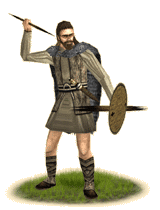 The Iovamann are formed from some of the poorest members of Lusotannan society, those who live off their flocks of sheep and goats at the top of the mountains of Lusitania. They are armed with several "sude", which is a wooden javelin, sharpened and fire-hardened on both ends. While this would seem ineffective, it can play havoc with lightly armoured enemies. They have only a coarse wool tunic for protection, so they are among the most vulnerable soldiers to cavalry or missile counterfire. Luckily, they have a nearly inhuman ability to hide in tall grass and thick terrain, allowing them to ambush enemy columns and seemingly disappear into thin air. They are armed only with a knife for melee, so they must be guarded from any hand to hand combat. The Iovamann are formed from some of the poorest members of Lusotannan society, those who live off their flocks of sheep and goats at the top of the mountains of Lusitania. They are armed with several "sude", which is a wooden javelin, sharpened and fire-hardened on both ends. While this would seem ineffective, it can play havoc with lightly armoured enemies. They have only a coarse wool tunic for protection, so they are among the most vulnerable soldiers to cavalry or missile counterfire. Luckily, they have a nearly inhuman ability to hide in tall grass and thick terrain, allowing them to ambush enemy columns and seemingly disappear into thin air. They are armed only with a knife for melee, so they must be guarded from any hand to hand combat.
Historically, these warbands were the lightest and among the most 'annoying' harassment troops that the Romans had to deal with. They caused many casualties before they retired back into the night or hills and attacked again the following day. When the Romans imported good light cavalry to help in their wars against the Iberian tribes, their job got a whole lot harder!
Gestikapoinann (Lusotannan Light Spearmen)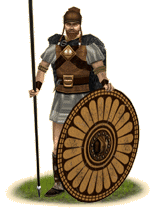 The Gestikapoinann are the semi-professional line infantry of the Lusotannan. They are well in life, owning farmland and cattle and taking the occasional mercenary service to pay for their equipment. They are equipped with light armour made of leather combined with a small bronze breastplate, a "galea" leather helmet and a rather large shield that gives them their name. Their armament includes a bundle of javelins and a sturdy spear. In battle they form a loose shieldwall that can stand most regular cavalry, but may be at a disadvantage against better trained assault infantry. The Gestikapoinann are the semi-professional line infantry of the Lusotannan. They are well in life, owning farmland and cattle and taking the occasional mercenary service to pay for their equipment. They are equipped with light armour made of leather combined with a small bronze breastplate, a "galea" leather helmet and a rather large shield that gives them their name. Their armament includes a bundle of javelins and a sturdy spear. In battle they form a loose shieldwall that can stand most regular cavalry, but may be at a disadvantage against better trained assault infantry.
Historically, these men are in the same social category of the Caetranann, but chose to go to combat in a different kit. They were the Lusotannan response to the very effective Iberian cavalry that could just run over other infantry that were not equipped to handle them.
Iabarannta (Ambushers)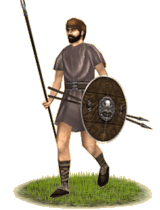 The Iabarannta (I-ab-ah-ran-tah; "Ambushers") are made up of the lower warrior class and the upper-freemen of the Lusotannan society. These are the men who live off their farms, herds and flocks, and complement it by raiding other tribes' territories. These activities afford them a decent battle kit for their culture which they use to further their social and economical status. They are armed with javelins and a spear, along with a buckler and a leather cap to protect them but nothing else. Being otherwise unprotected, they trust their speed and agility to stay out of the reach of heavier enemies while pelting them with their javelins. While not completely incompetent in a melee it really should be their last recourse, after all their javelins have been spent and the enemy is tired or in disarray.
The Iabarannta (I-ab-ah-ran-tah; "Ambushers") are made up of the lower warrior class and the upper-freemen of the Lusotannan society. These are the men who live off their farms, herds and flocks, and complement it by raiding other tribes' territories. These activities afford them a decent battle kit for their culture which they use to further their social and economical status. They are armed with javelins and a spear, along with a buckler and a leather cap to protect them but nothing else. Being otherwise unprotected, they trust their speed and agility to stay out of the reach of heavier enemies while pelting them with their javelins. While not completely incompetent in a melee it really should be their last recourse, after all their javelins have been spent and the enemy is tired or in disarray.
Historically, these lighter troops were one of the most numerous Lusitanian types of warriors, and were a part of every army they sent into enemy territory – either for simple raiding or great invasions. The Lusitanians were masters of fast attacks, pursuits and feigned retreats, and light skirmishing troops were fundamental in executing these tactics. When properly supported these men were able to cut off retreats, harass supply lines and lower the enemy morale to the point of making the enemy winter before the campaigning season was over.
Caetranann (Lusotannan Light Infantry)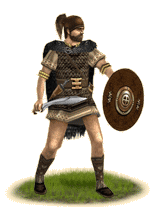 The Caetranann are the Lusotana variant of the typical Caetratii found in all Iberian armies, and no less fierce than their Iberian brethren. These men are used to a constant state of warfare, having served on countless raids and attacks on neighbouring tribes, probably having even served as mercenaries at some point which afforded them their equipment. They wear light quilted linen armour, besides the tunics and thick cloaks that also give a degree of protection. They wear a tough sinew and leather helmet called a "galea" and carry a bundle of javelins to throw before the melee. Their javelins make them ideal skirmishers, and their earth toned clothing allows them to excel at ambushes. They carry a number of these javelins, and charge with their falcata and caetra when these are spent. They are just as skilled in melee as the other Caetratii, but their skirmishing ability is much more developed. The Caetranann are the Lusotana variant of the typical Caetratii found in all Iberian armies, and no less fierce than their Iberian brethren. These men are used to a constant state of warfare, having served on countless raids and attacks on neighbouring tribes, probably having even served as mercenaries at some point which afforded them their equipment. They wear light quilted linen armour, besides the tunics and thick cloaks that also give a degree of protection. They wear a tough sinew and leather helmet called a "galea" and carry a bundle of javelins to throw before the melee. Their javelins make them ideal skirmishers, and their earth toned clothing allows them to excel at ambushes. They carry a number of these javelins, and charge with their falcata and caetra when these are spent. They are just as skilled in melee as the other Caetratii, but their skirmishing ability is much more developed.
Historically, the Lusotannan Caetranann were among the most feared Lusitanian soldiers to face the Romans. Their ability to hide in tall grass and to seemingly appear out of nowhere worries and vexes their opponents, and many guerilla battles were won by these hardy men.
Scortamareva (Lusotannan Medium Spearmen)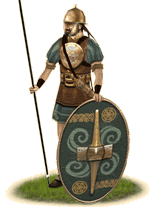 These men are some of the most well equipped and heaviest warriors the Lusotannan can muster. They are a fierce, well drilled and well equipped force, making them a great medium infantry that will be likely to stand well against most enemy unit types. Such warriors are considered wealthy by Lusotannan standards, having acquired their gear through trade, mercenary services or sponsorship by an important chief of the somewhat rich coastal towns. They are armed with a well made Iberian steel shortsword, a bronze breastplate, greaves, a bronze montefortino helmet and well made javelins and spear. These men are some of the most well equipped and heaviest warriors the Lusotannan can muster. They are a fierce, well drilled and well equipped force, making them a great medium infantry that will be likely to stand well against most enemy unit types. Such warriors are considered wealthy by Lusotannan standards, having acquired their gear through trade, mercenary services or sponsorship by an important chief of the somewhat rich coastal towns. They are armed with a well made Iberian steel shortsword, a bronze breastplate, greaves, a bronze montefortino helmet and well made javelins and spear.
Historically, Lusitania was a land of contrasts. In an early period the Lusitanians were a landlocked people that inhabited the hills of what is now Northeastern Portugal and parts of Spain clinging on to their last strongholds, and after facing the Celtic threat they once again descended from the highlands and reoccupied most of their lost land. In the interior lived the poor tribes of hillmen and mountaineers of definite Indo-European influence, which relied on herding as their primary economic activity, while on the coast decidedly Mediterranean-influenced cities, existed virtually autonomous and subsisted off farmland and commerce along the coast and rivers. These were the richest parts of Lusitania, where the richest artefacts are found and the place these well equipped warriors came from.
Ambakaro (Lusotannan Elite Shock Infantry)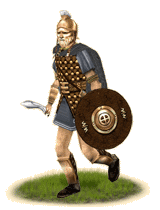 The Ambakaro ("Arms Bearers") are men that have proved their valour and dedication to their chieftains in the heat of battle. While their background may vary, they all have in common a religious oath of fealty sealed by sacred rites. They are fanatical about keeping their honour and are granted land, cattle and arms as a reward for their services. They protect themselves with a form of light armour made up of quilted linen under a composite of leather, "esparto" fibers and connecting metal pins that is good at absorbing cutting blows. They also use their trademark bronze helmets with the "bucula" ("facemask") along with the standard steel falcata and caetra known of other Iberian warriors. They, however, fight with a degree of élan and ferocity that is not often matched by any enemy. Besides all this, they throw the "gesso" before melee, which is a long range light javelin suitable for picking enemies off at a great distance. The Ambakaro ("Arms Bearers") are men that have proved their valour and dedication to their chieftains in the heat of battle. While their background may vary, they all have in common a religious oath of fealty sealed by sacred rites. They are fanatical about keeping their honour and are granted land, cattle and arms as a reward for their services. They protect themselves with a form of light armour made up of quilted linen under a composite of leather, "esparto" fibers and connecting metal pins that is good at absorbing cutting blows. They also use their trademark bronze helmets with the "bucula" ("facemask") along with the standard steel falcata and caetra known of other Iberian warriors. They, however, fight with a degree of élan and ferocity that is not often matched by any enemy. Besides all this, they throw the "gesso" before melee, which is a long range light javelin suitable for picking enemies off at a great distance.
Historically, the Ambakaro were the elite infantry of the Lusotannan and the personal foot guard of the Lusitanian chieftains. They were bound by religious oaths of fealty and usually defended their lord to the death being praised by Julius Caesar himself. When their lord died, they would often kill each other in ritual combat as part of the funerary rites so they could accompany him to the afterlife.
Ambakaro Epones (Lusotannan Elite Medium Cavalry)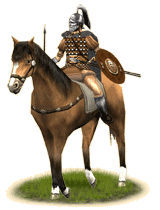 The Ambakaro Epones ("Mounted Arms Bearers") are men that have proved their valour and dedication to their chieftains in the heat of battle. While their background may vary, they all have in common a religious oath of fealty sealed by sacred rites. They are fanatical about keeping their honour and are granted land, cattle and arms as a reward for their services. They protect themselves with a form of light armour made up of quilted linen under a composite of leather, "esparto" fibers and connecting metal pins that is good at absorbing cutting blows. They also use their trademark bronze helmets with the "bucula" ("facemask") along with the standard steel falcata and caetra known of other Iberian warriors. They, however, fight with a degree of élan and ferocity that is not often matched by any enemy. Besides all this they ride the famous Lusitanian warhorse from which they throw the "gesso", a long range javelin suitable for picking enemies off at a great distance, before entering a melee. Although not a numerous unit of Lusitanian armies, these cavalrymen are fundamental as scouts and, most of all, as good skirmishing medium cavalry, allowing them to use the agility and speed of their horses. They are courageous and very competent but should use avoid spear infantry at all costs. The Ambakaro Epones ("Mounted Arms Bearers") are men that have proved their valour and dedication to their chieftains in the heat of battle. While their background may vary, they all have in common a religious oath of fealty sealed by sacred rites. They are fanatical about keeping their honour and are granted land, cattle and arms as a reward for their services. They protect themselves with a form of light armour made up of quilted linen under a composite of leather, "esparto" fibers and connecting metal pins that is good at absorbing cutting blows. They also use their trademark bronze helmets with the "bucula" ("facemask") along with the standard steel falcata and caetra known of other Iberian warriors. They, however, fight with a degree of élan and ferocity that is not often matched by any enemy. Besides all this they ride the famous Lusitanian warhorse from which they throw the "gesso", a long range javelin suitable for picking enemies off at a great distance, before entering a melee. Although not a numerous unit of Lusitanian armies, these cavalrymen are fundamental as scouts and, most of all, as good skirmishing medium cavalry, allowing them to use the agility and speed of their horses. They are courageous and very competent but should use avoid spear infantry at all costs.
Historically, the Ambakaro were the personal guard of the Lusitanian chieftains. They were bound by religious oaths of fealty and usually defended their lord to the death being praised by Julius Caesar himself. When their lord died, they would often kill each other in ritual combat as part of the funerary rites so they could accompany him to the afterlife. Lusitanian cavalry were not often used, but when they were, they were able to inflict an almost always decisive blow. These horsemen were used to great effect against Roman infantry that could not catch the fast and agile horses of this warlike people – “It is well known that in Lusitania, in the vicinity of the town of Olisipo and the river Tagus, the mares, by turning their faces towards the west wind as it blows, become impregnated by its breezes, and that the foals which are conceived in this way are remarkable for their extreme fleetness" - Pliny, CHAPTER 67
Iberi Velites (Iberian Skirmishers)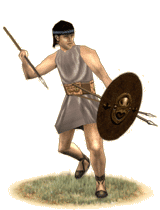 The Iberians also produce exceedingly good light skirmishing infantry, which these men embody. They carry several javelins, each with a hard iron head that plays havoc with lightly armored or unarmored men. They come from the poorest classes of Iberian society, and only have their "caetra" for protection. These men cannot afford the standard sword that most Iberian soldiers would be armed with, so they must make due with a short spear. They are not particularly adept fighters in melee, and can be chopped to pieces at the leisure of nearly any cavalry. They can be deadly against slow moving infantry, however. The Iberians also produce exceedingly good light skirmishing infantry, which these men embody. They carry several javelins, each with a hard iron head that plays havoc with lightly armored or unarmored men. They come from the poorest classes of Iberian society, and only have their "caetra" for protection. These men cannot afford the standard sword that most Iberian soldiers would be armed with, so they must make due with a short spear. They are not particularly adept fighters in melee, and can be chopped to pieces at the leisure of nearly any cavalry. They can be deadly against slow moving infantry, however.
Historically, the skirmishers came from the poorest of the Iberian tribesmen. They were usually landless peasants who were gathered together to fight as a cheap light screening infantry. As such, their morale would normally have been low, but due to the characteristic fierceness of the Iberian tribes, these men often fight until casualty levels compel them to retire. They are effective in melee so long as they are fighting enemy light infantry. Anything heavier would have born a hole right through them. They were hated by the Romans, who had to contend with their nasty javelins at every turn.
Trokalobutiamm (Shepherd Slingers)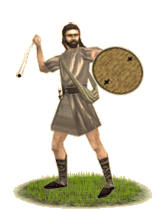 The Trokalobutiamm (Tro-kay-low-boot-i-am; "Herds/Field Worker Combatants") are shepherds that have been banded together to fight as a unit of slingers. They’re made up from the lower classes of all peninsular tribes and nations, who mostly scrape off a living grazing small flocks of sheep and goats on arid hills. Being so poor and with a high demand for slingers, it’s no wonder these hardy highlanders have come down the hills seeking to join bandit groups or to offer their services as mercenaries in urban armies. Armed only with their sling and a knife, they are also largely unprotected besides their small wicker buckler. That makes them extremely vulnerable to any troops that can catch them in a melee and even light cavalry is likely to just run through them without breaking a sweat.
The Trokalobutiamm (Tro-kay-low-boot-i-am; "Herds/Field Worker Combatants") are shepherds that have been banded together to fight as a unit of slingers. They’re made up from the lower classes of all peninsular tribes and nations, who mostly scrape off a living grazing small flocks of sheep and goats on arid hills. Being so poor and with a high demand for slingers, it’s no wonder these hardy highlanders have come down the hills seeking to join bandit groups or to offer their services as mercenaries in urban armies. Armed only with their sling and a knife, they are also largely unprotected besides their small wicker buckler. That makes them extremely vulnerable to any troops that can catch them in a melee and even light cavalry is likely to just run through them without breaking a sweat.
Historically, with the abandonment of the bow by the end of the Bronze Age, the sling was the only long-ranged missile weapon to be found in 3rd century Iberia. It had always been the weapon of choice of the shepherd, who relied on its range and accuracy to keep predators such as wolves and lynxes from threatening his valuable flock. It is no wonder then, that these men constituted the majority of slingers present in battle, driven by their hard-life in the hills into mercenary service. Despite using rounded rocks in their day-to-day life, they were supplied by their lords with clay and lead shot for better performance in battle. So ubiquitous was the sling that its ammunition remains today one of the most numerous finds in military contexts.
Iberi Milites (Iberian Light Spearmen)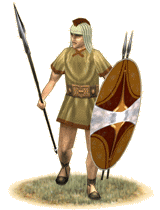 These men are occasional warriors that are levied when there is dire need for it. Recruited from all professions of Iberian society, they form a surprisingly reliable and versatile militia. As many warriors in Iberia, they use the usual combination of javelin + spear to fight. Although ill-equipped light spearmen, as their only protection is given by their sinew helms and their traditional large oval shields, their skirmishing abilities and speed makes them a nuisance in many situations if used properly. Although not as reliable as more permanent or experienced warriors like Caetratii or Scutarii, they are handy to reinforce the line or when springing tactical ambushes on enemy units. Even though they are mostly untrained, in accordance with most men in the Iberian peninsula they are no strangers to the disputes among tribes and are on a much higher level of skill and morale than other levied troops. These men are occasional warriors that are levied when there is dire need for it. Recruited from all professions of Iberian society, they form a surprisingly reliable and versatile militia. As many warriors in Iberia, they use the usual combination of javelin + spear to fight. Although ill-equipped light spearmen, as their only protection is given by their sinew helms and their traditional large oval shields, their skirmishing abilities and speed makes them a nuisance in many situations if used properly. Although not as reliable as more permanent or experienced warriors like Caetratii or Scutarii, they are handy to reinforce the line or when springing tactical ambushes on enemy units. Even though they are mostly untrained, in accordance with most men in the Iberian peninsula they are no strangers to the disputes among tribes and are on a much higher level of skill and morale than other levied troops.
Historically, the militias were mostly organized among the southern Iberians as a way to respond to sudden unexpected pillage incursions of other tribes, that came mostly from the poorer northern, mountainous regions of Iberia. This permanent state of alert throughout the decades creates harder, higher skilled men and, even if only "occasional" warriors, they were known to have far greater resilience in battle than expected for levy infantry.
Iberi Caetrati (Iberian Light Infantry)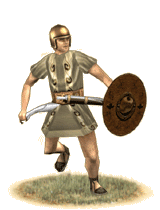 Caetrati are a deceptive type of infantry. Well able light troops, they can skirmish while softening their enemy before closing in for hand-to-hand combat. Although sometimes they use their mobility to keep them out of the reach of enemies, they are quite often able to produce very unpleasant surprises to units not normally vulnerable to light troops. Four things contribute to this capability: their agility on the battlefield, their all-metal heavy javelins ("soliferum"), the traditional Iberian ferociousness and their superb swordsmanship. They are not, however, due to their light equipment and occasional warrior status, designed to face experienced heavy troops and should be spared to those types of combat. Their lack of anti-cavalry weapons and armour also makes them very vulnerable to such enemies. Caetrati are a deceptive type of infantry. Well able light troops, they can skirmish while softening their enemy before closing in for hand-to-hand combat. Although sometimes they use their mobility to keep them out of the reach of enemies, they are quite often able to produce very unpleasant surprises to units not normally vulnerable to light troops. Four things contribute to this capability: their agility on the battlefield, their all-metal heavy javelins ("soliferum"), the traditional Iberian ferociousness and their superb swordsmanship. They are not, however, due to their light equipment and occasional warrior status, designed to face experienced heavy troops and should be spared to those types of combat. Their lack of anti-cavalry weapons and armour also makes them very vulnerable to such enemies.
Historically, the Caetratii were one of the most numerous type of troops in Iberian armies. They were multi-purpose light infantry made up of non-professional soldiers that filled several roles generally reserved to various types of troops. Although most Iberians were not professional soldiers, they were very used to constant tribal warfare and, as such, became skilled and resolute. Caetratii were known for their unique style of swordsmanship that employs two specific types of equipment: a curved heavy-tipped sword known as "falcata" and the small, agile buckler the Romans called "caetra". Hannibal lavished upon his Caetratii, and many of them wore white linen tunics with a crimson border.
Iberi Equites Caetrati (Iberian Light Cavalry)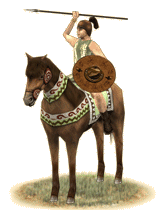 The Equites Caetrati are a very useful light skirmishing cavalry. Their surefooted, agile Iberian horses and ability to fight in a melee for a limited duration make up for their lack of armour or heavier weaponry. The Equites Caetratii are armed with several javelins and the standard Iberian "falcata" and "caetra" combination. They are very good horsemen, but do not have any armor at all other than their shields and caps. This could be a disadvantage to less hardy horsemen, but the Equites Caetratii make up for it by trading protection for agility, stealth and resistance. They are excellent skirmishing cavalry, able to carry many javelins and hurl them at enemy formations while staying out of that formation’s reach. The Equites Caetrati are a very useful light skirmishing cavalry. Their surefooted, agile Iberian horses and ability to fight in a melee for a limited duration make up for their lack of armour or heavier weaponry. The Equites Caetratii are armed with several javelins and the standard Iberian "falcata" and "caetra" combination. They are very good horsemen, but do not have any armor at all other than their shields and caps. This could be a disadvantage to less hardy horsemen, but the Equites Caetratii make up for it by trading protection for agility, stealth and resistance. They are excellent skirmishing cavalry, able to carry many javelins and hurl them at enemy formations while staying out of that formation’s reach.
Historically, Equites Caetratii were used many times to great effect by the Carthaginians. The Iberians used them more as stealthy, mobile guerrilla troops to harass and cut down a few unwary enemies before disappearing back into the hills. This was possible due to one of the surprising characteristics in Iberian armies: their peculiar training of horses. They were taught to keep silent and laying down, in all situations when their rider told them to. As such, many of the deceptive ambushes performed by Iberian tribes were even more surprising to the incautious enemy.
Iberi Scutari (Iberian Medium Spearmen)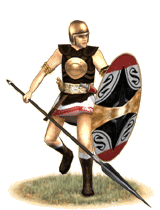 These Iberian spearmen are referred to as Scutarii by the Romans because of their large oval shields (the Latin word for shield being "Scutum"). They are well-equipped medium spearmen, being armed with the dreaded all-metal [I]soliferum[/I], a spear as their main weapon, a short straight sword and a small dagger for backup. They protect themselves with a combination of leather armour and bronze breastplate. When all this equipment is put together you are left with an extremely versatile and quick infantry. As more permanent warriors than the Caetratii, they are more experienced and skilled, as well as better equipped and protected, generally forming the main line in Iberian armies. They use their "soliferum" before closing in for hand-to-hand combat. Although being considered by enemies as heavier troops then the Caetratii, they are, nevertheless, fast and come in handy when springing tactical ambushes on enemy units. Most Iberian warriors were known for their determination and skill and Scutarii are no exception. They are, with the traditional Iberian ferociousness, quite determined. These Iberian spearmen are referred to as Scutarii by the Romans because of their large oval shields (the Latin word for shield being "Scutum"). They are well-equipped medium spearmen, being armed with the dreaded all-metal [I]soliferum[/I], a spear as their main weapon, a short straight sword and a small dagger for backup. They protect themselves with a combination of leather armour and bronze breastplate. When all this equipment is put together you are left with an extremely versatile and quick infantry. As more permanent warriors than the Caetratii, they are more experienced and skilled, as well as better equipped and protected, generally forming the main line in Iberian armies. They use their "soliferum" before closing in for hand-to-hand combat. Although being considered by enemies as heavier troops then the Caetratii, they are, nevertheless, fast and come in handy when springing tactical ambushes on enemy units. Most Iberian warriors were known for their determination and skill and Scutarii are no exception. They are, with the traditional Iberian ferociousness, quite determined.
Historically, the design of the later Roman legionary sword (or "gladius") was influenced by the blades carried by these men (known by the Romans as "gladius hispanniensis"). This design was adopted after Roman armies had faced large formations of Scutarii during the First Punic War.
Loricati Caetrati (Iberian Medium Infantry)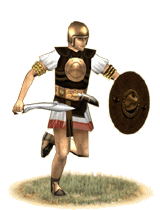 The Iberians are famous the world over for their extremely versatile and excellent quality light infantry. Loricatii Caetratii are no exception. Among the most able and skilled warriors, some men became veterans and assume in Iberian warfare a more permanent warrior role near their chieftains. Used to take advantage of the spoils of war that more permanent fighters are able to enjoy, these men are therefore better equipped than the lighter Caetratii, having as protection a breastplate and leather armour combination supplementing their "bascinet"-type bronze helm. Fighting with the traditional "soliferum" + "falcata" + "caetra" set, and being more motivated and resilient than greener troops, they are dangerous foes able to strike vulnerable spots in the enemy lines. These men are a step above normal light infantry, and they can be relied upon to defeat far more heavily armored opponents in battle. They are vulnerable to cavalry though, due to their lack of anti-cavalry weapons. The Iberians are famous the world over for their extremely versatile and excellent quality light infantry. Loricatii Caetratii are no exception. Among the most able and skilled warriors, some men became veterans and assume in Iberian warfare a more permanent warrior role near their chieftains. Used to take advantage of the spoils of war that more permanent fighters are able to enjoy, these men are therefore better equipped than the lighter Caetratii, having as protection a breastplate and leather armour combination supplementing their "bascinet"-type bronze helm. Fighting with the traditional "soliferum" + "falcata" + "caetra" set, and being more motivated and resilient than greener troops, they are dangerous foes able to strike vulnerable spots in the enemy lines. These men are a step above normal light infantry, and they can be relied upon to defeat far more heavily armored opponents in battle. They are vulnerable to cavalry though, due to their lack of anti-cavalry weapons.
Historically, as with most Iberian warriors, weapons were a matter of preference and depended on the style of fighting they used. Therefore, some men had equipment to become considered Scutarii but preferred the use of the "falcata" and "caetra" to the spear, "gladius" and large oval shield combination. Veteran and well-equipped Caetratii were among the most feared opponents of the Romans. With their martial art of sword and buckler fighting allied to the unpredictability of Iberian ambushes, they were excellent in single combat and were often able to surprise and kill Roman soldiers in this manner. In unit combat, they were almost as fierce, easily equaling the Roman Hastatii.
Iberi Curisi (Iberian Medium Cavalry)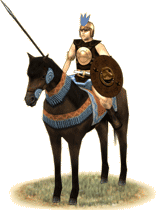 The Curisi are no different from most cavalrymen in Iberia. They are surprisingly good horsemen for a country with common rough terrain. Riding their agile, resilient Iberian horses they are good medium cavalry that are able to perform the role of shock against light troops. They wear bronze helmets and chest plates combined with leather armor, which gives them staying power in a melee contest. They carry the normal "falcata" and "caetra" combination of the Iberian tribes, which allows them to hold their own in a melee situation, although being more adept at spearing down fleeing enemies. They are armored and fast enough to stand up to most light and medium cavalry and some medium infantry, but will generally get cut to pieces by heavier spear infantry or cavalry. A good commander will take this into account. The Curisi are no different from most cavalrymen in Iberia. They are surprisingly good horsemen for a country with common rough terrain. Riding their agile, resilient Iberian horses they are good medium cavalry that are able to perform the role of shock against light troops. They wear bronze helmets and chest plates combined with leather armor, which gives them staying power in a melee contest. They carry the normal "falcata" and "caetra" combination of the Iberian tribes, which allows them to hold their own in a melee situation, although being more adept at spearing down fleeing enemies. They are armored and fast enough to stand up to most light and medium cavalry and some medium infantry, but will generally get cut to pieces by heavier spear infantry or cavalry. A good commander will take this into account.
Historically, the Iberian Curisii were excellent medium cavalry, being used by the Carthaginians, due to their agility, in a more versatile screening role than heavier cavalry. Iberian tribes used them in the same task on occasions of open confrontation, but preferred to take advantage of their stealth before using them in a surprise charge against enemy units, as all Iberian horses were trained to be quiet and silent. This skillful training of Iberian horses combined well with hit and run surprise tactics. Due to the lack of quality of Roman cavalry, they almost always had an advantage that was muted somewhat with the arrival of mercenaries from Numidia and the eastern steppe. In addition, the Curisii demonstrated their great ability to chase down light cavalry, making them truly a unit deserving of the fame given them.
Loricati Scutari (Iberian Heavy Infantry)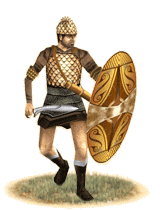 During the Second Punic War, Hannibal found that the Italian troops under his command were less than able to be trusted with thThose skilled men among the Iberian tribes that can either afford scale armor and bronze grieves or be sponsored by a noble who can. This armor makes them one better than their mostly lower class counterparts. They also carry the famous Gladius Hispanicus, making them excellent anti-infantry soldiers when combined with their ovular shields. They are also useful against heavily armored soldiers due to their soliferum, an iron javelin that was known for its ability to pierce armor. The Armored Scutarii are the best of the Iberian line troops, able to stand up to their legionary counterparts. They are best used where the fighting will be the hardest, leaving less armored companions to fight where there will be lighter resistance. During the Second Punic War, Hannibal found that the Italian troops under his command were less than able to be trusted with thThose skilled men among the Iberian tribes that can either afford scale armor and bronze grieves or be sponsored by a noble who can. This armor makes them one better than their mostly lower class counterparts. They also carry the famous Gladius Hispanicus, making them excellent anti-infantry soldiers when combined with their ovular shields. They are also useful against heavily armored soldiers due to their soliferum, an iron javelin that was known for its ability to pierce armor. The Armored Scutarii are the best of the Iberian line troops, able to stand up to their legionary counterparts. They are best used where the fighting will be the hardest, leaving less armored companions to fight where there will be lighter resistance.
Historically, the Loricatii Scutarii were some of the most vicious of the Iberian soldiery. They were used exclusively by Iberian chieftains and were the best of the regular line infantry. They fought mainly in battles where lines were used and not in the guerilla battles across Iberia. They were last used by the Pompey brothers in the battles against Caesar. They were actually able to break Caesar’s army, only to be routed in turn when Caesar himself charged their line while cursing his own men as cowards. At this point, Caesar’s army turned and utterly routed the Iberians and Roman deserters.
Iberi Lanceari (Iberian Heavy Cavalry)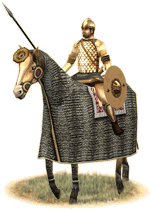 These hardy Iberians are among the choicest units available to a Carthaginian commander. They are a good all-purpose heavy cavalry, and they have a staying power on the battlefield that is simply unmatched by all but the most elite cavalry forces. They do not suffer from the same morale problems that the other Iberian troops in the service of a foreign power do since they are usually lavished upon by their commanders and their officers marry into Carthaginian or Liby-Phoenician families. They wear good quality mail armor and carry long Iberian style ovular shields. This combined with their use of a cavalry spear and falcata make them ideal cavalry for both the charge and fierce melee. These are probably the most versatile heavy cavalry in the world, and their status in the Carthaginian army proves this. These hardy Iberians are among the choicest units available to a Carthaginian commander. They are a good all-purpose heavy cavalry, and they have a staying power on the battlefield that is simply unmatched by all but the most elite cavalry forces. They do not suffer from the same morale problems that the other Iberian troops in the service of a foreign power do since they are usually lavished upon by their commanders and their officers marry into Carthaginian or Liby-Phoenician families. They wear good quality mail armor and carry long Iberian style ovular shields. This combined with their use of a cavalry spear and falcata make them ideal cavalry for both the charge and fierce melee. These are probably the most versatile heavy cavalry in the world, and their status in the Carthaginian army proves this.
Historically, the Iberian heavy cavalry was the most instrumental unit aside from the African Infantry at the battle of Cannae. They showed their martial prowess to an extreme degree by driving both the Roman and Allied heavy cavalry off the battlefield, turning and proceeding to drive the Roman light cavalry off the battlefield, then turning once more to completely surround the Roman infantry. Most cavalry would have been content with simply chasing after the Roman heavy cavalry. It takes a great deal of discipline to turn thrice, all without a commander of note during the battle! After ten years of fighting in Italy two thirds of these men were still at Hannibal’s side!
Gaesamica (Javelineers)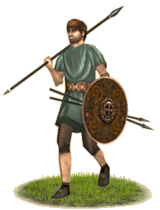 The Gaesamica (Guy-sah-mek-ah; "Javelineers") constitute the majority of Celtiberian warriors who fought as light spearmen. They’re fast, being proficient at flanking manoeuvres and harassing the enemy line before joining the melee. Lightly equipped however with just a buckler and a leather cap, they shouldn’t be used as line infantry, being better suited for the flanks, supporting heavier troops.
The Gaesamica (Guy-sah-mek-ah; "Javelineers") constitute the majority of Celtiberian warriors who fought as light spearmen. They’re fast, being proficient at flanking manoeuvres and harassing the enemy line before joining the melee. Lightly equipped however with just a buckler and a leather cap, they shouldn’t be used as line infantry, being better suited for the flanks, supporting heavier troops.
Made up of the lower classes of warriors and freemen who own weapons, these men are generally only used to raiding the enemy’s outlying villages and herds, preferring to stay out of the more serious border disputes. These times however may bring with them a need for greater numbers of warriors to fight increasingly larger enemy armies.
Theirs is a simple battle-kit, made up of a leather cap, the Iberian caetra, a bundle of javelins and a decent spear that they use in a light infantry or medium skirmisher role.
Historically, the Celtiberians were a numerous people that organized themselves roughly in seven tribes which occupied the central plateau of modern day Spain. It is generally accepted that they were formed by a migratory wave of Celts during the fifth century BC, who came to rule over a pre-existing Iberian stratum and eventually intermarried with it. This is the origin of their name, already used in antiquity. Their society was based around the oppidum (hill fortress-city) of which craftsmen, farmers and herders were dependent, and who were in turn protected by a dedicated warrior class. The basis of their economy was cattle-raising that was supplemented by farming, trading, raiding and mercenary service.
Of the seven main tribes, the Arevaci became the dominant force. The other tribes were the Belli, Titti, Lusones, Lobetani, Berones and the Palendones. True to their martial traditions, the Celtiberians first enter history as mercenaries in Sicily and continue to appear in other conflicts along the Mediterranean. However, war would come closer to home during the Second Punic War as Romans and Carthaginians battled for control of the Eastern coast of Iberia, having served on both sides with equal valour. Following the eventual defeat of Carthage, the greatest hour of the Celtiberian people would be in resisting the might of Rome as she extended her domains westward.
In the last Celtiberian war, leading the confederated forces of the Celtiberians were the Arevaci of Numantia, a powerful oppidum near the source of the Durios River. Twice they inflicted disastrous defeats on superior forces, sealing what they hoped would be peace treaties that would allow them to remain independent while allowing the Romans to keep their honour – unfortunately for them the Senate would not accept anything but a total victory. Ultimately it took the conqueror of Carthage, the grandson of Scipio Africanus himself, to break the brave Celtiberians. The war ended in the siege of Numantia where very few people survived, preferring to end their own lives rather than submit to foreign rule.
Dunaminica (Celtiberian Heavy Infantry)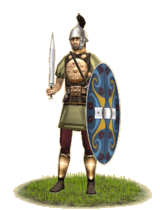 Hailing from the Celtiberi, ferocious and battle-hardened, the Dunaminica (Dun-a-min-eek-ah; "Fort Soldier") are the best regular footmen in Iberia, and widely regarded as some of the best mercenaries on this part of the world. They are the cream of the warrior class of their culture, and are equipped as such with a short-sword, armour-piercing javelins, a large shield, a metal helmet and metal greaves.
Hailing from the Celtiberi, ferocious and battle-hardened, the Dunaminica (Dun-a-min-eek-ah; "Fort Soldier") are the best regular footmen in Iberia, and widely regarded as some of the best mercenaries on this part of the world. They are the cream of the warrior class of their culture, and are equipped as such with a short-sword, armour-piercing javelins, a large shield, a metal helmet and metal greaves.
These are men of station who have a stake in the fate of their oppida, and will fight to the death to protect their social status, and the honour and independence of their people – the Celtiberian fanatical defence of their lands is legendary. As warriors, they are used to the relatively low-intensity warfare that goes into raiding enemy tribes, but also quite familiar to marching abroad in large numbers to serve as mercenaries in the wars that regularly consume the Mediterranean.
Their weapons and armour are those common to the Celtiberian elite. For weapons they have the famous Gladius Hispaniensis, which would become the Roman standard sword, complemented by javelins similar to the Roman light pilum. To protect themselves, they carry a scutum, a Celtic ‘Montefortino’ helmet, Iberian bronze greaves and an elaborate set of breastplates. They should be used as assault infantry, leading the attack of the rest of the line infantry.
Historically, the Celtiberians were a numerous people that organized themselves roughly in seven tribes which occupied the central plateau of modern day Spain. It is generally accepted that they were formed by a migratory wave of Celts during the fifth century BC, who came to rule over a pre-existing Iberian stratum and eventually intermarried with it. This is the origin of their name, already used in antiquity. Their society was based around the oppidum (hill fortress-city) of which craftsmen, farmers and herders were dependent, and who were in turn protected by a dedicated warrior class. The basis of their economy was cattle-raising that was supplemented by farming, trading, raiding and mercenary service.
Of the seven main tribes, the Arevaci became the dominant force. The other tribes were the Belli, Titti, Lusones, Lobetani, Berones and the Palendones. True to their martial traditions, the Celtiberians first enter history as mercenaries in Sicily and continue to appear in other conflicts along the Mediterranean. However war would come closer to home during the Second Punic War as Romans and Carthaginians battled for control of the Eastern coast of Iberia, having served on both sides with equal valour. Following the eventual defeat of Carthage, the greatest hour of the Celtiberian people would be in resisting the might of Rome as she extended her domains westward.
In the last Celtiberian war, leading the confederated forces of the Celtiberians were the Arevaci of Numantia, a powerful oppidum near the source of the Durios River. Twice they inflicted disastrous defeats on superior forces, sealing what they hoped would be peace treaties that would allow them to remain independent while allowing the Romans to keep their honour – unfortunately for them the Senate would not accept anything but a total victory. Ultimately it took the conqueror of Carthage, the grandson of Scipio Africanus himself, to break the brave Celtiberians. The war ended in the siege of Numantia where very few people survived, preferring to end their own lives rather than submit to foreign rule.
Dosidataskeli (Vasci Armoured Shock Infantry)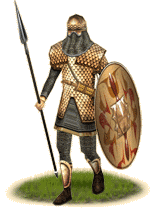 The Dosidataskeli were a unit of exceedingly heavily armed and armored shock infantry that were the foot bodyguards of the Vasci kings. They were recruited exclusively in Cantabria-Vasconnia, where they originated. They are armored in Ceannlann, which is a top layer of small scales armor fastened to a layer of felt to which is sewn a layer of chain. The result is a nearly impenetrable but flexible armor that is even resistant to armor piercing weapons. The Dosidataskeli are used to break the center of an enemy line. They first throw their solifera in order to disrupt and kill many enemy soldiers, and then they charge with their heavy spears and fight in melee until their enemy runs. Their job is simple, and they are frighteningly good at it. They are useful against any infantry or cavalry. Their only disadvantage is their expense and rarity. The Dosidataskeli were a unit of exceedingly heavily armed and armored shock infantry that were the foot bodyguards of the Vasci kings. They were recruited exclusively in Cantabria-Vasconnia, where they originated. They are armored in Ceannlann, which is a top layer of small scales armor fastened to a layer of felt to which is sewn a layer of chain. The result is a nearly impenetrable but flexible armor that is even resistant to armor piercing weapons. The Dosidataskeli are used to break the center of an enemy line. They first throw their solifera in order to disrupt and kill many enemy soldiers, and then they charge with their heavy spears and fight in melee until their enemy runs. Their job is simple, and they are frighteningly good at it. They are useful against any infantry or cavalry. Their only disadvantage is their expense and rarity.
Historically, the Dosidataskeli were feared enough to be written about by Greek historians. Stories of their fierceness was enough to inspire the Seleucids to design their own unit that was frighteningly similar to them and to export the mail veil east, where it was used by the Parthians. They were exported from Iberia and were instrumental in the first unifications of Ireland as well. The numbers of these soldiers must have always been low, due to the sheer expense of their equipment and training, and the size of the men that would form the unit. Still, if used correctly, the Dosidataskeli can be an extremely powerfull shock infantry.
Balearic Slingers (Balearic Slingers)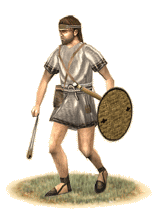 Trained from a verly early age in the use of their various types of slings and projectiles, they have reached an extremelly rare proeficiency in long range skirmishing. Fast, due to their light equipment, and with much more precision and power than other slingers, they are ideal mercenaries to have in any army that can afford their services. Contrary to most light skirmishers, their experience can be used effectivelly to strike down any unorganized foes in hand-to-hand combat. As any light infantry, they are vulnerable to cavalry. Trained from a verly early age in the use of their various types of slings and projectiles, they have reached an extremelly rare proeficiency in long range skirmishing. Fast, due to their light equipment, and with much more precision and power than other slingers, they are ideal mercenaries to have in any army that can afford their services. Contrary to most light skirmishers, their experience can be used effectivelly to strike down any unorganized foes in hand-to-hand combat. As any light infantry, they are vulnerable to cavalry.
Historically, the Balearic Slingers became famous throughout the Mediterranean world due to their increadible skill in battle. These skills prompted the Carthaginians and Romans to use them whenever they were able to do so. A good example of the skill that won them renow is Diodorus Siculus' chronicle of the Battle of Eknomos in 311BC: "But when Hamilcar saw that his men were being overpowered and that the Greeks in constantly increasing number were making their way into the camp, he brought up his slingers, who came from the Balearic Islands and numbered at least a thousand. By hurling a shower of great stones, they wounded many and even killed not a few of those who were attacking, and they shattered the defensive armour of most of them. For these men, who are accustomed to sling stones weighing a mina, contributed a great deal toward victory in battle, as they practised constantly with the sling since childhood. In this way they drove the Greeks from the camp and defeated them. Their equipment for fighting consists of three slings, and of these they keep one around the head, another around the belly, and the third in the hands. In the business of war they hurl much larger stones than do any other slingers, and with such force that the missile seems to have been shot, as it were, from a catapult; consequently, in their assaults upon walled cities, they strike the defenders on the battlements and disable them, and in pitched battles they crush both shields and helmets and every kind of protective armour. And they are so accurate in their aim that in the majority of cases they never miss the target before them. The reason for this is the continual practice which they get from childhood, in that their mothers compel them, while still young boys, to use the sling continually; for there is set up before them as a target a piece of bread fastened to a stake, and the novice is not permitted to eat until he has hit the bread, whereupon he takes it from his mother with her permission and devours it!!".
Clona Tekonac (Northern Axemen)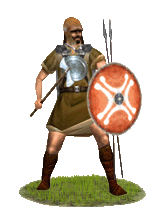 The Astures and the Cantabrii were groups of indigenous tribes with a similar Celtic-influenced but distinctive culture, which were well-known for their fierceness, lust for freedom and indomitable character. These mountain and valley dwellers were rather poor and primitive, lived on cattle and acorn, had matriarchal uses and became feared by their neighbours for their affinity to robbery and their plundering raids. They were also very appreciated as mercenaries for their endurance and bravery. The Astures and the Cantabrii were groups of indigenous tribes with a similar Celtic-influenced but distinctive culture, which were well-known for their fierceness, lust for freedom and indomitable character. These mountain and valley dwellers were rather poor and primitive, lived on cattle and acorn, had matriarchal uses and became feared by their neighbours for their affinity to robbery and their plundering raids. They were also very appreciated as mercenaries for their endurance and bravery.
Hannibal employed a small contingent of Cantabrian foot warriors among his Iberian troops. They were encouraged to fight till death through a loyalty sacred pact, a 'devotio iberica'. Their leader then, named Laro, was reportedly a gigantic man feared for his mastery in the use of the bipenne axe.
The Cantabrii and the Astures are both skilled on horse and on foot. When fighting on foot, they can fight competently in close formation, but they're specially effective and fast in the rough terrain where they spend most of their lives, and they're well used to harsh weather and lack of food, making them specially apt for guerilla warfare and ambush tactics. Living in regions where iron is quite common and cheap, they employ a variety of armour, shields and weapons, including ranged weapons like soliferri, and melee weapons like Iberian falcata, or more commonly, one-handed bipenne axes they use with dreadful speed and skill.
Milites Ilergetum (Ilergetan Soldiers)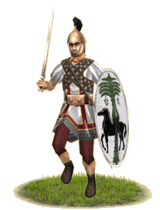 The Milites Ilergetum ("Ilergetan Soldiers") constitute the main infantry force of the Ilergetes, a powerful people that hails from North-eastern Iberia, bordering to the west the mighty Celtiberians, of whom they are natural enemies. They represent a good quality but not quite elite contingent in the Ilergetan army. They are brave, and relatively well equipped with a helmet, padded armour, a scutum and a longsword making them well able to stand in a line as dependable infantry.
The Milites Ilergetum ("Ilergetan Soldiers") constitute the main infantry force of the Ilergetes, a powerful people that hails from North-eastern Iberia, bordering to the west the mighty Celtiberians, of whom they are natural enemies. They represent a good quality but not quite elite contingent in the Ilergetan army. They are brave, and relatively well equipped with a helmet, padded armour, a scutum and a longsword making them well able to stand in a line as dependable infantry.
Unlike the Celtiberians who centred their society on their local oppida, the Ilergetes are in this respect more like the Iberians on the coast, who have actual kings and oligarchies to rule them. And while the territory that each of these kings and their dependents control is not large, each of them can raise a small host from which a bigger army can be assembled under a high-king to fight in set-piece battles.
Their defensive equipment is a helmet of typical Ilergetan design, with the characteristical neck guard, padded armour and a large scutum adopted from the Gallic tribes across the Pyrenees. For weapons they use javelins and a longsword that was most likely imported from Gaul through the Greek colony of Emporion. The scabbard however has been modified to be used slung over the shoulder in the Iberian style, rather than the original belt slide more typical of the Gallic custom.
Historically, the Ilergetes were either Iberianized Celtiberians or Celticized Iberians that lived in the Aragonese area of modern Spain. The question lies in whether the migratory Celts actually imposed themselves on an Iberian substratum, or whether their society was just heavily impacted by Celtic influences at different points in their history. What is certain is the existence of Iberian inscriptions in their territory while no such Celtiberian finds exist.
Greek and Phoenician elements were also abundant in their culture, foreign motifs being common in their art. Theirs was an advanced society which relied on herding and wheat farming as their primary sources of sustenance, while at the same time being heavily involved in trading activities with the interior as well as the coast having used bronze and silver coins from at least the 3rd century BC. Their capital was Atanagrum and other important cities were Eso and Iltirda. They were a powerful and expanding people, which occupied a strategic position, being intermediaries between the coastal and interior tribes. It was only natural that when the Second Punic War started, they would be at the centre of things. Under their high-king, Indibilis, they would fight for the most part on the side of the Carthaginians against Rome and her allied tribes such as the Edetani or Celtiberi (of which the majority had sided with the Romans at that point). Their help would be instrumental in the destruction of the Roman armies commanded by the Scipio brothers in 212 B.C and after changing sides, the capture of New Carthage in 209 B.C.
Following the Carthaginian defeat at Ilipa, Rome’s attention would focus on submitting those who had sided with her enemies or that posed a threat. Despite having raised great armies and fighting bravely, the Ilergetes were defeated in two great battles, the last of which also claimed the life of their leader Indibilis. Having been submitted they were further humiliated by having the walls of their cities demolished and their weapons destroyed as part of the armistice. Later, this once great people would be forced to ask for Roman help, being incapable of defending itself against its enemies and thus faded into history as part of the growing Empire.
Callaecae Roscaithrera (Callaeci Medium Infantry)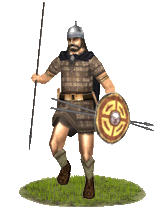 These men are practically the finest warriors the nobility of the Callaeci tribes can muster. Equipped with the best weapons the region has to offer - multiple soliferra all-iron javelins and a local development of the ubiquitous Celtic longsword - they are certainly good medium infantry, and a match for any warrior in their class, even if a bit lightly protected with just an iron helmet and a caetra shield. These men are practically the finest warriors the nobility of the Callaeci tribes can muster. Equipped with the best weapons the region has to offer - multiple soliferra all-iron javelins and a local development of the ubiquitous Celtic longsword - they are certainly good medium infantry, and a match for any warrior in their class, even if a bit lightly protected with just an iron helmet and a caetra shield.
In times of peace they practice a kind of armed dance, similar to those practised in Britannia, which require a great deal of dexterity to do properly, effectively training them for combat. In war they march at an even step, and then raise a battle-song as they charge on their foe. Also, the rugged terrain of the Callaeci homeland means they are also used to skirmishing tactics in addition to more linear warfare, so while they are at a disadvantage against heavier enemies, in a straight fight they can use their versatility to even up the odds.
Historically, the Callaeci were a brave and numerous group of tribes that made their home North of the Lusitani, across the river Douro. They arrived during the period of Celtic migrations, displacing or conquering existing cultures, and carved up kingdoms for themselves in an area roughly equivalent to Northern Portugal and present day Galicia (in Spain), which to this day still bears it's name. They were an independently-minded people who fought against other Iberian tribes, but later eagerly joined forces with some of them to stem the Roman tide.
The lack of horse-related items that exist abundantly in the cultures around them, make us believe that they were almost exclusively foot-soldiers (though they may have, like the Saxons centuries later, ridden to the battlefield and dismounted for combat). Their equipment is very well attested in primary texts, and archaeological finds, notably the famous Callaeci warrior statues.
Cantabrae Eponereidam (Cantabrian Light Cavalry)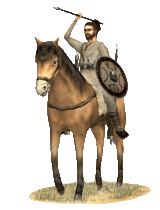 Mounted atop their small horses, these men of the Cantabri tribes are with the possible exception of the Numidians, the best skirmisher cavalry in the western world. Their shaggy, sure-footed horses are not quite as fast as the larger Iberian breed, but are much more at home among the hills, bogs and forests of their rugged northern homelands. They are very good horseman and extremely agile when it comes to dodging missiles, which almost makes up for their lack of real protection. Since they wear only a rough tunic and cloak, their caetra shield is their sole defence. As for weapons, they have a multitude of javelins and a falcata sword as their side-arm. Mounted atop their small horses, these men of the Cantabri tribes are with the possible exception of the Numidians, the best skirmisher cavalry in the western world. Their shaggy, sure-footed horses are not quite as fast as the larger Iberian breed, but are much more at home among the hills, bogs and forests of their rugged northern homelands. They are very good horseman and extremely agile when it comes to dodging missiles, which almost makes up for their lack of real protection. Since they wear only a rough tunic and cloak, their caetra shield is their sole defence. As for weapons, they have a multitude of javelins and a falcata sword as their side-arm.
They are really only suited for skirmishing tactics, and normally stay away from prolonged melee, preferring instead to discharge an enormous barrage of javelins. Their signature formation is the ‘Cantabrian Circle’ – they would form a single-file rotating circle and as the men came around to face the enemy formation they would let their missile fly. The effect was a continual stream of javelins onto a typically close ordered enemy. It also had the added advantage of making individual riders hard to target.
Historically, the Cantabri were an independently minded Celtic-influenced people that lived a very poor existence in the rugged hills of modern northern-eastern Spain. Their land had very little arable land and forced them to raid their neighbours to south or hire themselves out in the various wars that consumed Iberia at any given time. Their most famous contingent was without a doubt, their skirmishing cavalry which frustrated the Romans with their ability to cut down any forager they dared to send ahead of the army, before disappearing back into the hills. Eventually, in the reign of Augustus, after several aptly named "Cantabrian Wars" they were mostly wiped out – their homes reduced to charcoal and their people to slaves and serfs of Roman veteran colonies.
Clona Gosnasio (Northern Iberian Skirmisher)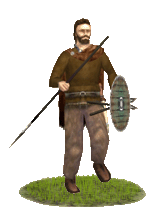 These warriors make up the most poorly armed men of the Northern Iberian Celts, and as such make up the bulk of the forces those tribes can field in a time of war. In essence they are a transition between a skirmisher and light infantry, for they are relatively fiercer than other peoples' support troops and expected to be a part of some of the hand-to-hand fighting if given an opportunity. However, armed with a bundle of javelins, a spear and protected only by a small shield, they should not be confused with real light infantry and should not be expected to bear a protracted melee against a well-organized and prepared enemy. These warriors make up the most poorly armed men of the Northern Iberian Celts, and as such make up the bulk of the forces those tribes can field in a time of war. In essence they are a transition between a skirmisher and light infantry, for they are relatively fiercer than other peoples' support troops and expected to be a part of some of the hand-to-hand fighting if given an opportunity. However, armed with a bundle of javelins, a spear and protected only by a small shield, they should not be confused with real light infantry and should not be expected to bear a protracted melee against a well-organized and prepared enemy.
Historically, these would be the most common footmen found in the tribal levies of such people as the Callaeci, the Asturi or the Cantabri. Lightly armed and armoured they were really only useful as fiercer skirmishers, but still no match for dedicated line infantry fielded by other nations. They usually stuck to ambushes and skirmishing tactics, retreating in the face of an organized enemy, but pursuing in turn when the enemy pulled back or grew disorganized.
|
 |
|
 |






















|